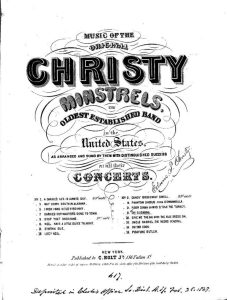
[Portrait of Mr. John Comfort Fillmore]. Photographs. Place: National Anthropological Archives, Smithsonian Institution.1
Fillmore presents the scales of these songs in Western notation on the ignorant basis that, “the Indians have no musical notation, no theories of music whatsoever.”3 His deprecating comments continue when describing how he felt obligated to harmonize the versions of these songs since, “the harmonic sense of these peoples is underdeveloped.”4 Fillmore’s imposition of Western notation and harmony onto these songs is an excellent example of “colonial imposition,”5 which is a term used by Beverly Diamond in Music and modernity among First Peoples of North America to describe inadequate documentation of Native American music through the use of Western notation.
Fillmore’s intentions and biases are made clear at the end of the article, where his initial intentions of using the music of Native Americans to “test the naturalness of our own musical perceptions”6 lead to his far-fetched conclusion that Native American music contains a “noble religious feeling [akin to] the central idea of Christianity.”7 Contrary to popular ideas of the time, he does advocate for Native American music as being “worthy of comparison to some of the best [music] we possess ourselves,”8 but only after his unwelcome imposition of Western notation to create versions of Native American music that “the Indians couldn’t have produced unaided.”9
Though much of ethnomusicology has changed over the course of its existence, some things remain the same, both positive and negative. Browner notes that the employment of fieldwork as the main method of ethnomusicological research has remained the same throughout history.10 Similarly, although the field has advanced greatly over time, the misrepresentation demonstrated through Fillmore’s article and research methods remains something to be aware of within ethnomusicology today.
Bibliography
1 https://library.artstor.org/asset/NMNH_125725565.
2 John Comfort Fillmore. “A STUDY OF INDIAN MUSIC.1.” Century Illustrated Magazine (1881-1906), 02, 1894, 616, https://www.proquest.com/magazines/study-indian-music-1/docview/125524446/se-2.


